|
~~ Sinclair Strip Mine! ~~
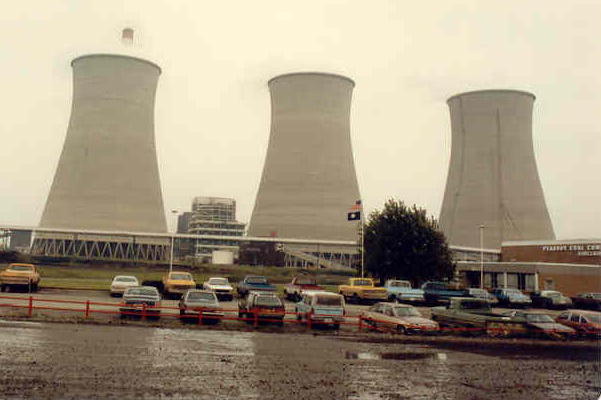
Peabody's Sinclair Strip Mine Office.
TVA Cooling Towers In Background.
Picture taken in mid sixties.
In the later years of the
nineteen fifties, Peabody and the Tennessee Valley Authority had worked out an agreement.
Like the massive equipment that Peabody Coal Company owns and operates and like the huge
generating equipment that TVA operates, this agreement was enormous. It was probably
one of the largest "Coal Purchasing" contracts that had ever been made. It would also
entail Peabody building one of the largest "Shovels" ever build and TVA building the
largest power plant in that time frame. The cost of producing electricity is mind
boggling and a very large part of that cost is for the purchase of coal. The cost
of transportation of the coal is a large part of the coal cost. Now, if a power plant
was near a producing coal mine, the total cost of the coal would be decreased. Enter
Peabody with the ability to open a new mine in the Paradise, Kentucky area
````
In the late nineteen fifties, work was started on the building of the shovel. Bucyrus-Erie
Company got the contract to build the world's largest shovel. It took two years to
build and each piece was shipped by rail to the new mine at Paradise. The mine was
to be named Sinclair Strip Mine. Roads had to be built and a special rail line was made.
Special rail cars were made just to haul some of the parts of this big shovel. The
assembly of the shove took eleven months. A construction site existed and once the
mine became operational, some of the construction people became miners. In the mean
time, TVA was building the world's largest power plant nearby. In the early nineteen
sixties, the Sinclair Mine became operational as well as the Paradise Steam Plant. For
the next twenty-five years, Sinclair Mines and Paradise Steam Plant were partners in
the production of power. In 1986, the mine had removed most of the coal in the area
and shut down. Paradise Steam Plant secured other contracts for a continuous supply
of coal and continues to operate. Most of the construction people that wanted to were
able to find jobs with either TVA or Sinclair. When Sinclair Mine shut down, a lot
of the miners retired.
Peabody's 3850 Shovel.
The large "Strippers"
of a strip mine and in some cases, the big "Loaders" are referred to by a number. The
Shovel at Sinclair was referred to as the "3850". Until recently, I have always thought
that a "Shovel" or a "Dragline" was unique and no other shovel would be called by the
same number. Guess that I thought that the number was a serial number more so than a
model number. Anyway, the picture of the 3850 below is not the 3850 that was used at
Sinclair. The 3850's are all similar, although not identical. Most people probably
could not tell the difference. I have been told that the Sinclair 3850 had a larger
diameter electrical power cord. I am sure there are some other differences, but all
are built on the same type frame. The picture of the 3850 was furnished by Dale Thomas.
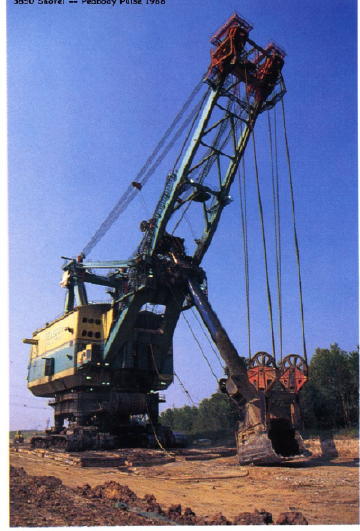
A person would think that the "Office Complex" of a company would be the main center
of attention. Not with "Strip Mines". The office is a necessary part of a company.
Payroll, operating decisions and plans, personnel, safety, and etc., are all formed
from the office. Shut the office down for a week and the mine continues. Shut the
"Stripper", down for an hour and every miner knows about that and will stop anything
that they are doing to see if they can help get the stripper working. The office may
operate twelve hours or so six days a week. The stripper operates continuously year
around. No vacation for that big machine. As stated earlier, the stripper removes
the overburden from a seam of coal. Once the seam is exposed, a "Loader" will dig
the coal and load it on a truck. Hence, the term, loader.
Peabody's Loader, loading coal from a Sinclair Mine Pit..
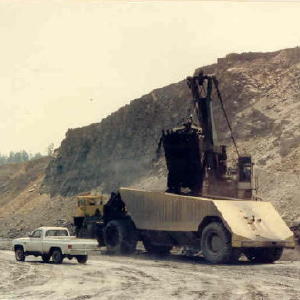
Once a stripper enters a mine area and starts to "Strip" or remove the overburden,
that area becomes known as a "Pit" and when being mined, it is an active pit. The
"Loader" operates in the pit to dig the coal and to load it into massive trucks, where
it is transported from the pit to a processing plant or a transfer point. Sinclair
Mine was a "Mine to Plant" operation and the coal trucks would leave the pit with a
100 plus tons of coal and transport it to the TVA's Paradise Steam Plant. The loaded
truck would drive over the plant hopper and dump the coal into massive storage hoppers
and in most cases without stopping. Then it was back to the pit for another load.
Peabody's Coal Truck.
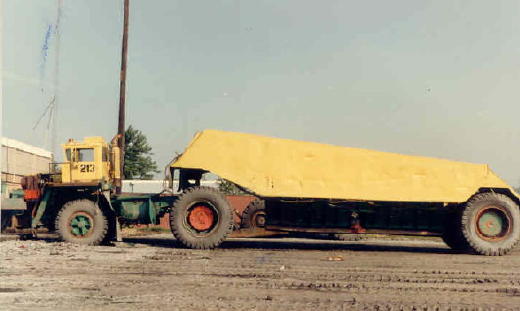
How would you like to fix a flat on one of these trucks? Oh yeah, these tires do go
flat and they do wear out. Better still, how would you like to purchase a set of tires
for this coal truck?
Peabody's Vertical Drill.
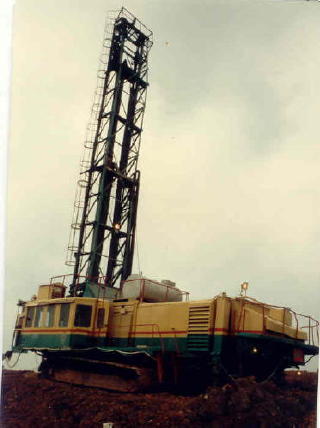
As with any "Big Production", the main attraction or event will have "Bit Players"
that are important to the "Star" of any production. Without the secondary equipment
and operators, the "Big Shovel" would soon cease to dig. The "Dozers" and the "Cats"
move the dirt to build roads, levees, dams and smooth out the "Spoil". They also
pull various equipment in and out of pits. The "Graders" keep the gravel roads smooth
and the "Water Truck" will keep them from being dusty. Electricians keep the lights
on as well as to keep the power readily available to the strippers and loaders. The
"Drill" operates in front of the stripper and drills holes either vertically or
horizontally and above the coal seam where a "Shooter" can load a blasting powder
into the holes where it can be exploded to loosen up the overburden. Mechanics of
all types, welders, blacksmiths, office personnel, clerks, and surveyors are other
vital positions that keep a mine operating. Operators of conveyor belts and many
other operating positions are needed and used in a "Strip Mine". The list is almost
endless and I have probably left out several crafts and pieces of equipment. I apologize
if I left out any craft or position. Feel free to contact me if you see any obvious
omission of personnel or if I have not correctly presented a position or a fact.
Power Source!
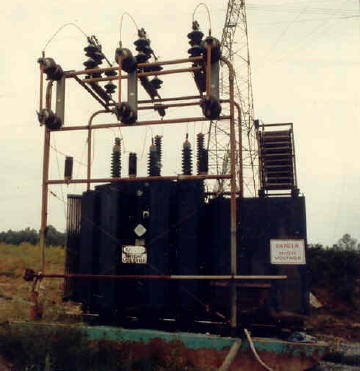
Sinclair Mines was furnished power directly from the Paradise Steam Plant. Most,
if not all, of the power produced from a Power Plant is placed directly onto power
lines or the "Power Grid". Another unique situation with the Peabody-TVA contract
was that TVA would supply power directly to the Sinclair Mine. TVA had a transformer
bank in the TVA Transformer Yard that was a dedicated transformer to the Sinclair Mine.
The power from Paradise was placed on transmission lines at a voltage of 500,000 Volts
or 500 KV. This special and unique "Sinclair" transformer supplied power to the
Sinclair Mine at 69,000 Volts. The mine main transformer was a 7,500 KVA transformer
and it stepped this 69 KV power down to 7,200 volts. The output of this transformer
supplied the entire mines with power. One output supplied the "Hot Houses" with 7.2 KV
that fed the pit. Another output of the main transformer fed the mine power lines.
This voltage was 7.2 KV and went to the various garages, shops, offices and other
places where electricity was needed. The power was then stepped down to 4160 volts
and finally to 110 Volts when it was used for lighting, heating and air conditioning.
Again, please feel free to correct any and all statements that are not correct. Thanks
in advance.
Power Supply Houses For The Pit.
Portable "Hot Houses".
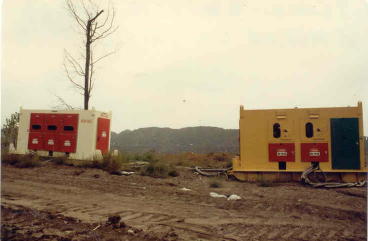
These portable devices supplied three phase electrical power to the active pit. Voltage
from the main transformer supplied power to the white portable house. The white portable
house fed the yellow houses. From the yellow houses, power cables were run to the
active pit to supply power to the stripper, the loader, as well as other equipment.
The supply cable to the stripper was a dedicated line, 1500 foot long, and about as
big as a person's thigh. In effect, the cables were big extension cords. As the stripper
moved, it drug the power cable with it. When the stripper moved away from the "Hot
House" and ran out of cable, there was another Yellow house on top of the pit. The
stripper was shut down and the old power cable was switched over to the new cable.
This process continued over and over. These houses were safety devices and they
contained equipment to monitor the electricity. Fault protection devices, as well as
current overload and voltage overload relays would interrupt the power if a faulty or
dangerous condition existed. Some earlier power sources to the pit was with 440 Volts.
The Sinclair Mine used 6900 volts to power the pit equipment.
~~~~~
In the prime time of the existence of the 3850 Shovel, records were broken. This mine
produced more coal in a period of time than any other mine. Muhlenberg County was
the largest producer of coal in the state of Kentucky, the USA and probably the world.
The 3850 Shovel set records on the amount of overburden that it moved. When the 3850
was first built, it was the largest piece of equipment that could travel under its'
own power. I am convinced that NASA looked at this shovel when they were thinking
about building equipment that could transport the space ships. All of the coal that
was being mined went to Paradise Steam Plant. At the time, it was the largest coal
fired power plant in existence. The two 700 MW Generators were the largest of their
type. Plans were made for two more similar units to be build, but the decision was
to build an even bigger generator. A 1150 MW Generator was added later and it was
the largest ever built in that time frame. Records seem to be made to be broken and
most of these records have been surpassed. Men and machines wear out and the 3850
was no exception.
In 1986, Sinclair Mine had been in operation some twenty-five years and had removed
most of the coal in the area. The 3850 Shovel was not through. It had been a "star"
and the center of attention for almost three decades and it had one more job to perform.
With fanfare, the news media, a lot of the miners, the company that build the machine
and the company that operated the machine, State and Federal Government and the EPA
looking on, the 3850 had one more big dig to make. It would now be used to dig its'
own grave. The 3850 faced the new pit and started to dig. It settled into its' final
resting place and was soon covered with the Kentucky soil and rocks that it had been
digging for a quarter of a century. Goodbye Old Machine.
Thanks for looking.
See you......
jrd
| |